Brooke A. Edmunds, Paula H. Flynn, and Mark L. Gleason
Department of Plant Pathology
Iowa State University
mgleason@iastate.edu
Michael Hazen is the field supervisor in charge of nursery production for Johnson Nursery. Located in the Upper Midwest, Johnson Nursery provides a full line of both bare-root and container-grown plants to the nursery industry, with more than 6 million plants held in their cold storage facilities each year. Woody plants make up the bulk of the sales, but hostas and daylilies, which are herbaceous perennials, are not far behind. Bare-root plants produced at the nursery's field sites are potted and distributed each spring to nursery dealers in 45 states. (Figure 1)
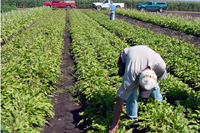
Figure 1.
It was one such dealer, Jerry Mullen, the owner of Jerry's Garden Center, with whom Michael had just spoken. Jerry called Michael's cell phone in a fury, accusing Johnson Nursery of shipping him diseased plants. The order, shipped in April, had included 300 hostas in one-gallon (3.7 liter) pots. Now it was late June and more than half of the plants had been sold to retail customers. Of the remaining 140 plants, Jerry had discarded more than 60 as unmarketable because they looked sick. Jerry also had received two complaints from his own customers, who indicated that the plants weren't doing well in the landscape.
Jerry described the problem as rotting of the plants at the soil line. The leaves were yellow and wilting, and it was easy to pull them off the plant. The bases of the petioles were rotted and brown. (Figure 2) White "threads" were visible on the rotted portion of the plant. (Figure 3) Numerous, 1- to 2-mm-diameter, reddish brown spheres were scattered on the infected petioles and potting medium surface of the rotted plants but were absent from the plants without problems. (Figure 4) At first Jerry thought these might be fertilizer granules, but the spheres were too small. (Figure 5)

Figure 2 |
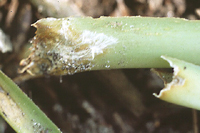
Figure 3 |
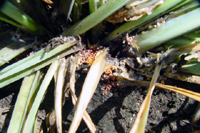
Figure 4 |

Figure 5 |
The plants had been healthy-looking until two weeks ago. About that time, the weather turned hot and humid, and the plants started wilting. Jerry didn't know what had caused the problem, but he was convinced that it wasn't his fault.
While assuring Jerry that he'd get to the bottom of this situation and promising to call him back the next day, Michael had a sinking feeling in his stomach. He knew exactly what Jerry's problem was and felt even worse because he also knew that his nursery was the most likely source.
Over the past three years, Michael had observed the same symptoms on hostas in several Johnson Nursery production fields. (Figures 6,7 and 8) When the problem first showed up, Michael dug up a few sick plants, took photos of the fields, and brought both to Laura Simpson, a consultant specializing in plant disease diagnosis. Laura examined the symptoms on the plants and placed some of the tiny spheres on nutrient agar plates.

Figure 6 |
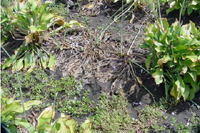
Figure 7 |

Figure 8 |
Based on the symptoms and results from agar-plate culturing, Laura diagnosed the problem as petiole rot, a disease caused by
Sclerotium rolfsii var.
delphinii, a soilborne fungus that attacks many species of plants. Laura also gave Michael some basic information about the life cycle of the disease cycle and explained why he needed to take it very seriously:
-
The fungus is very persistent in the soil. Although
S. rolfsii var.
delphinii does not produce any spores, it does generate sclerotia. These tiny spherical structures can survive in the field for several years, causing disease on susceptible plant species long after the original infected crop has been removed.
-
Sclerotium rolfsii var.
delphinii affects at least 20 genera of ornamental plants.
-
Sclerotia can spread and contaminate production fields by any production practice that moves soil. Mechanical cultivation activities, such as disking, plowing, or weed control tillage, are the main ways to spread within a field. Sclerotia also are easily spread from infested to uninfested fields in soil attached to farm equipment, tools, and even shoes, and by running water.
-
Petiole rot caused by
S. rolfsii var.
delphinii is difficult to recognize. Sclerotia of
S. rolfsii var.
delphinii are tiny and their color is hard to distinguish from soil, so they are easy to overlook. This makes scouting or inspection difficult, especially if the symptoms are not evident. (Figure 4)
-
Sclerotium rolfsii var.
delphinii is often introduced on plants, primarily on field-grown stock. This source could be either (a) plants that are grown at the nursery, then overwintered in cold storage and replanted in the nursery's own fields, or (b) new stock purchased from other nurseries.
When Laura had made her diagnosis 3 years earlier, Michael had attempted a management solution. He knew that it was best to try to avoid the disease in the first place. The field crews were already trained to survey the crowns for obvious disease symptoms before transplanting. Unfortunately, inspecting every crown for tiny sclerotia clinging to the crowns seemed too labor-intensive (and therefore too expensive) to be practical.
Another problem is that Johnson Nursery relied on mechanical tillage to control weeds. Michael knew this practice might be spreading the sclerotia as soil was moved throughout the field. Machinery is used several times a year, not only to prepare the fields but also to plant the crowns, apply fertilizer, control weeds, cut back the foliage each fall, and eventually undercut the root systems at harvest time during the fall. Using chemical herbicides could replace mechanical tillage for weed control, eliminating about 75% of the soil-disturbing activities, but a switch to herbicide would increase the cost of weed control.
Three years ago, Michael decided that the best solution was to begin a fungicide spray program in the 5-acre (2 ha) hosta field showing symptoms of
S. rolfsii var.
delphinii petiole rot. Three applications per season of the fungicide pentachloronitrobenzene (PCNB), at $16 per acre per spray, seemed to be a good compromise. It kept disease at a low level in that field and didn't add much in terms of labor or other costs.
What the company didn't anticipate was that plants in two more fields, totaling 20 acres (8 ha), would become infected over the next three years and also would require the fungicide treatment. No one knew whether the new infestations were introduced when planting the fields with crowns purchased from a supplier or through spread of sclerotia within Johnson Nursery. (Figure 9)
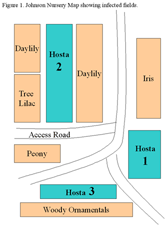
Figure 9
During these three years, Johnson Nursery went to considerable effort to apply fungicide to hostas from "problem" fields and to sell only healthy-looking plants to its customers. After a crop was harvested, it was brought into the packing shed. The crowns were shaken to remove attached soil from the roots, and rotted or discolored crowns were discarded. The next step was to divide the crowns. Workers cut the crowns into quarters, using either a band saw or a knife, depending on the size of the crown. (Figure 10) The pieces were then dipped in a fungicide to control storage rot fungi such as
Botrytis, packed in crates, and placed in cold storage for several months. In the spring, the crowns were transplanted into 1-gallon (3.7 liter) pots and shipped to wholesale customers. (Figure 11)

Figure 10 |
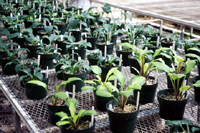
Figure 11 |
Keeping this history in the back of his mind, Michael now took a quick inventory of the infected hosta fields he had noted during the past growing season. He was very worried about another large loss of revenue to
S. rolfsii var.
delphinii. This year the disease caused losses of about $26,000 for the nursery. Losses had been approximately $14,000 last year and $7,500 the year before. Clearly, the problem was escalating despite the fungicide applications.
Johnson Nursery's worst nightmare was coming true: it was accused of selling diseased plants, and potentially alienating its own customers. Michael must manage the disease crisis more effectively, offer a solution to irate customers like Jerry, and act quickly, before the situation becomes even worse.
Michael is faced with a dilemma that many growers encounter: What should he do to stop losing money (i.e. salable hostas) to disease? Time is short and he needs to plan the spring nursery activities. He also needs to keep the disease from showing up in stock sold to customers or he'll be out of a job! Michael needs to devise a practical solution for this disease problem; what should he do?
DESCRIPTIONS OF AFFECTED FIELDS AND MAP OF NURSERY (Figure 9)
Field 1: A 0.8-acre (0.3 ha) field with 20,000 3-yr-old hosta plants. Disease incidence (% of field with symptomatic plants) was 30-40%. Most affected plants showed extensive collapse typical of petiole rot, with abundant production of sclerotia (at least several hundred sclerotia per plant). The plants were to be harvested within a few days.
Field 2: A 5-acre (2 ha) field with over 60,000 2-yr-old plants, in which disease incidence was about 1-2%.
Field 3: A 0.5-acre (0.2 ha) field with 5,000 1-yr-old hostas, in which disease incidence was <1% of plants.
Three-year-old hosta plants are usually large enough to be divided into quarters, with each division worth $3.50 when sold wholesale. Thus, each 3-year-old plant should be worth $14.00 in sales revenue.
